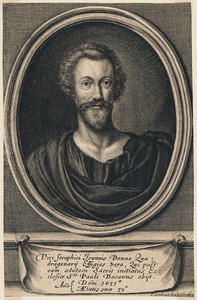| Method | Copper engraving |
| Artist | Pierre Lombart |
| Published | c.1651 |
| Dimensions | Image and sheet 150 x 97 mm |
| Notes |
A bust portrait, and frontis piece, of poet and preacher John Donne, first published in the 1651 edition of Letters to severall persons of honour. Donne is seen in an oval, directly facing the viewer. He wears classical style drapery, which is draped over his left shoulder. John Donne (1572–1631) English poet, preacher, and scholar. Born in London to a Roman Catholic family during a time of anti-Catholic laws, Donne studied at Hart Hall, now Hertford College, Oxford. After three years of studies, Donne attended the University of Cambridge, where he studied for another three years. Donne could not obtain a degree from either institution because of his Catholicism, as he refused to take the Oath of Supremacy required to graduate. In 1591 he was accepted as a student at the Thavies Inn legal school, one of the Inns of Chancery in London. In 1592, he was admitted to Lincoln's Inn, one of the Inns of Court. In 1596 he enlisted as a gentleman with the Earl of Essex's privateering expedition against Cádiz, and the following year he sailed with Sir Walter Raleigh and Essex in the near-disastrous Islands expedition, hunting for Spanish treasure ships in the Azores. Upon his return to London in 1597, Donne took on the role of secretary to Sir Thomas Egerton, the lord keeper of the great seal. He held this position for nearly five years, suggesting that by this point, Donne had likely converted to Anglicanism. Donne's life was marked by personal and financial difficulties, including struggles after his secret marriage to Anne More which temporarily damaged his career. He eventually became Dean of St. Paul's Cathedral and gained recognition for his sermons and writings. The eloquence of Donne's sermons soon gained him a reputation as the foremost preacher in the England of his day, and he became a favourite of both Kings James I and Charles I. Very little of Donne's writing was published during his life time with Anniversaries, published in 1611–12, being the only important poetic works by him published in his lifetime. Donne's early works of poetry often focused on love and sensuality, while his later poems and sermons reflected his religious devotion and contemplation of life and death. Notable works include his Holy Sonnets and his meditations, such as the famous passage "No man is an island." Pierre Lombart (1612/13 - 1681) was a French born engraver, working in both France and England. Although being a well recognised engraver in England, relatively little is known about his life. The first trace of Lombart in England is around 1649, and he went on to engrave numerous plates for Ogilby's various publications. Lombart's time in London can roughly be traced through his plates, which were usually inscribed with 'a Londres', and are dated until 1660. By 1663, he had returned to Paris, where he remained for the remainder of his life. O'Donoghue 6. Condition: Trimmed to image and tipped to album page. |
| Framing | unmounted |
| Price | £100.00 |
| Stock ID | 53360 |

